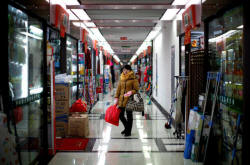|
Inflation picks up to
multi-year highs in China as central bank eyes tighter
policy
 Send a link to a friend
Send a link to a friend
 [February 14, 2017]
By Elias Glenn [February 14, 2017]
By Elias Glenn
BEIJING
(Reuters) - China's producer price inflation picked up more than
expected in January to near six-year highs as prices of steel and other
raw materials extended a torrid rally, adding to views that global
manufacturing activity is building momentum.
China consumer inflation also rose more than expected, nearing a
three-year high as fuel and food prices jumped, data showed on Tuesday.
Much of the pick up in consumer prices was likely due to higher food and
travel costs heading into the long Lunar New Year holiday, the National
Bureau of Statistics (NBS) said.
But mounting price pressures in China and many other countries have
sparked talk of tighter monetary policy this year, after years of
super-loose settings aimed at reviving economic growth.
China's central bank raised short-term interest rates in recent weeks as
it looks to contain risks from an explosive growth in debt, while
India's central bank last week unexpectedly signaled an end to its
longest easing cycle since the global financial crisis, citing inflation
risks.
Some analysts, however, believe the ramp up in price pressures in China
may be short-lived, noting that a jump in January food prices was likely
seasonal and that producer price gains slowed by half on a
month-on-month basis.
"We don't expect such high rates of inflation to last," Capital
Economics China economist Julian Evans-Pritchard said in a note.

"Tighter monetary policy, slowing income growth and cooling property
prices should keep broader price pressure contained over the
medium-term," he added, noting that weak prices early last year may have
exaggerated the strength of a reflationary trend seen in recent months.
Consumer inflation quickened to 2.5 percent in January from a year
earlier, the highest since May 2014.
But it is still well within the government's comfort zone of 3 percent,
and is showing few signs yet that the jump in producer prices is
filtering through to the broader economy, analysts say.
Analysts polled by Reuters had predicted the consumer price index (CPI)
would rise 2.4 percent, after a 2.1 percent gain in December.
Food prices, the biggest component of CPI, rose 2.7 percent in January,
led by a 7.1 percent increase in the price of pork.
Fuel costs surged 16.5 percent on-year, the biggest increase among CPI
components, likely due to a low comparison in the year-ago period when
fuel prices fell.
Capital Economics expects consumer prices to rise only 2.0 percent this
year.
Producer price inflation accelerated to 6.9 percent -- the fastest since
August 2011 -- from December's rise of 5.5 percent.
[to top of second column] |

A woman pauses as she shops at a wholesale market in Yiwu, Zhejiang
province January 11, 2011. REUTERS/Carlos Barria/File Photo

Gains in the producer price index (PPI) were driven by a 31.0 percent
increase in mining costs as coal prices rise, the biggest jump in that
category since early 2010.
The market had expected producer prices to rise 6.3 percent on an annual
basis.
But on a monthly basis, they only rose 0.8 percent, down from December's
1.6 percent gain.
China's massive imports of coal, crude oil, iron ore and industrial
materials have helped fuel a sharp rebound in global resources prices in
recent months, boosting profits for producers and processors.
Iron ore futures in China rose for a sixth session in a row on Tuesday,
hitting their highest in more than three years, while London copper
futures have climbed to around 20-month highs.
Price gains in China have been further amplified by government efforts
to reduce industrial overcapacity.
Investors are cashing in on the global reflationary trade. Shares of
Jiangxi Copper Co Ltd, China's biggest integrated copper producer, have
surged over 60 percent in the past year in Shanghai and 85 percent in
Hong Kong.
But heady increases in China's commodity futures market, especially for
iron ore, metal reinforcing bars and coking coal used in steel
production, have added to policymakers' worries about speculative price
bubbles.
Worries about speculation and debt risks led the central bank to move to
a tightening bias in recent months, not inflation, analysts say.
"Inflation is not the main driver of monetary policy at the moment...I
do think they are going to tighten more this year, but the main driver
is credit risk and concerns of leverage and what's going on in the
property market," said Capital Economics' Evans-Pritchard.
Banks in some big Chinese cities have started to reduce discounts on
mortgage rates for first-time home buyers, newspapers have reported,
joining recent steps to curb financial risks stemming from years of
loose credit conditions.
(Reporting by Beijing Monitoring Desk and Elias Glenn; Editing by Kim
Coghill)
[© 2017 Thomson Reuters. All rights
reserved.] Copyright 2017 Reuters. All rights reserved. This material may not be published,
broadcast, rewritten or redistributed.
 |